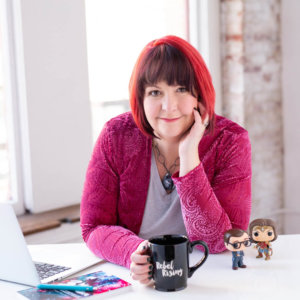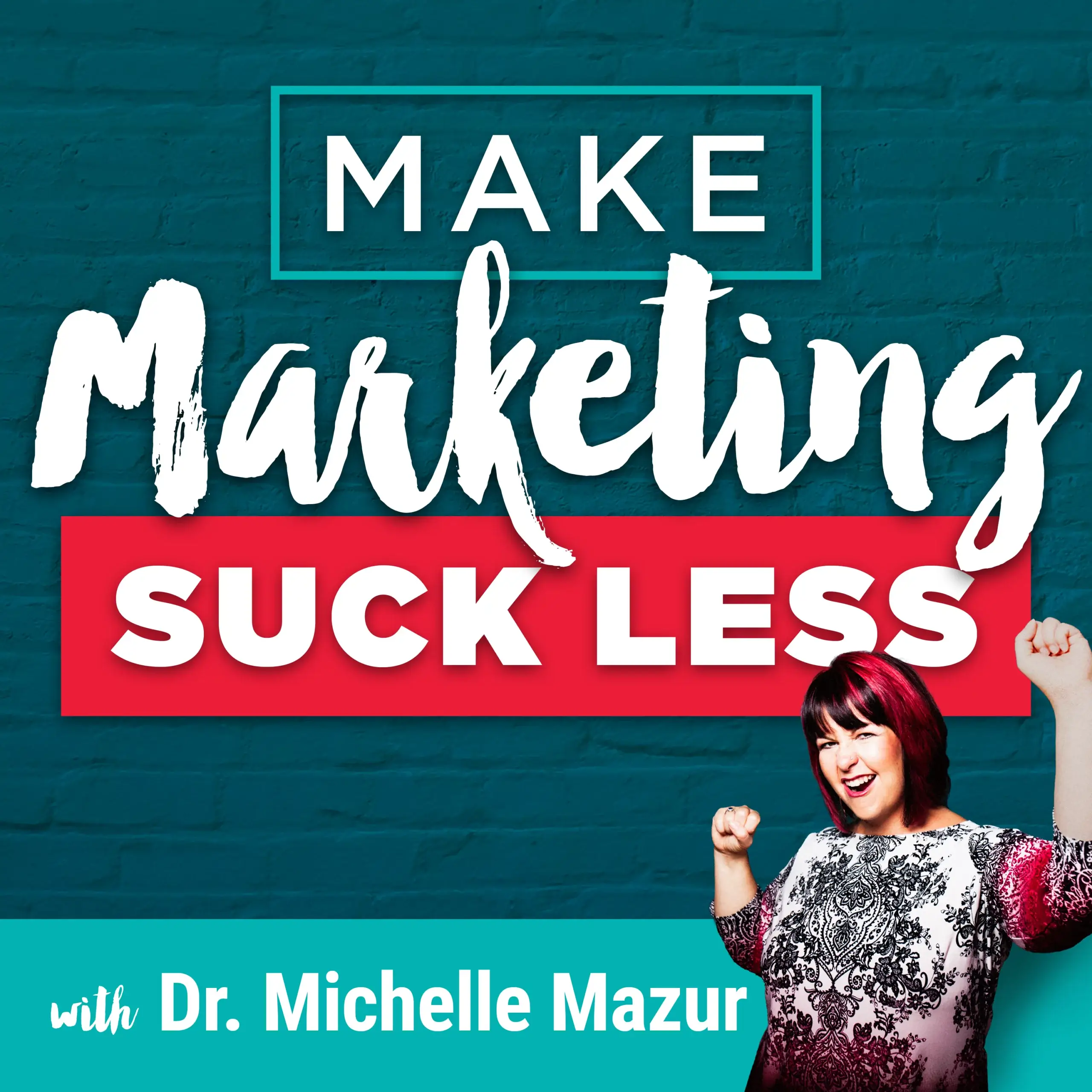Make Marketing Suck Less
Three Powerful Ways That Messaging Enhances Your Marketing
By Michelle Mazur > October 10, 2023
Filed Under Podcast

The other day in the Expert Up Club, a member asked me a question that surprised me.
It was right after one of our quarterly marketing retreats.
In these retreats, we're setting goals for the quarter ahead. We create marketing plans, and we figure out what marketing experiments they're going to run in order to figure out what actually works in their marketing.
A club member asked afterward, “So how does all of the messaging sprints relate to the marketing?”
Now you've heard me say on this podcast that messaging POWERS your marketing.
But today, I want to get specific and discuss the three ways messaging makes marketing easier and more effective.
(Click play or read the transcript below.)
In this episode:
- How to identify your “right-fit” client (and it’s not a bullshit client avatar)
- What is a driving belief statement, and why it’s important?
- How to guide people to what you offer
- How to use your messaging so people know what to expect
Learn more about Michelle Mazur:
Resources:
- Make Marketing Suck Less Newsletter
- Brenna McGowan, copywriter
- Uncertainty Reduction by Berger and Calabresi
Listen on your favorite podcast player or read the Transcript below:
Michelle Mazur [00:00:00]: The other day in the Expert Up Club, a member asked me a question that surprised me. It was right after one of our quarterly marketing retreats. In these retreats, we're setting goals for the quarter ahead, we create marketing plans, we figure out what marketing experiments they're going to run in order to figure out what actually works in their marketing. And the member of the club asked afterward, “So how do all of the messaging sprints that we're doing relate to the marketing?” Now you've heard me say on this podcast that messaging POWERS your marketing. But today, I want to get specific and talk about the three ways messaging makes marketing easier and more effective. So let's do this. Michelle Mazur [00:01:20]: Welcome to Make Marketing Suck Less. The podcast that knows marketing is freaking hard, especially when you're a solo business owner trying to juggle it all. I'm your host, Dr. Michelle Mazur, author of the 3 Word Rebellion and founder of the Expert Up Club. Forget the latest marketing fads and tactics promising social media stardom. I'm here with research-backed strategies to help you clarify your message and get twice as effective with your marketing. And while I can't promise you'll ever love marketing, I'm here to make you hate it a tiny bit less. Michelle Mazur [00:01:49] As a business owner, we have a very specific reason for marketing. 1. We want to grow our audience to the right size that supports our business. 2. We wanna make people aware of us. After all, if no one exists, how can they buy from us? 3. Our marketing should be helping people get ready to work with us. So I wanted to discuss 3 different pieces of messaging, which really supercharge and enhance your marketing efforts and help you achieve the goals. So let's talk about the first one. And the first one is about identifying your “right-fit” client. Now I am not talking about ideal client avatar bullshit because I've been there. I've been forced to do those client avatar exercises that produce something like: “Meet Mary. Mary is 47, and both of her kids have left for college. After she's a business owner and is passionate about what she does. In her free time, Mary likes to hang out with her cats, listen to eighties music, and watch The Morning Show on Apple TV.” Which is great, but Mary doesn't fucking exist. You can't market to people who don't exist. She's not a real person. And knowing that Mary likes cats doesn't really help you market effectively to her. I mean, unless you're selling cat toys or cat solutions, but for the most part, none of that stuff really helps. What does help when it comes to your messaging is to capture the language of your “right-fit”t client. Like, think about the clients that you love, three clients that you love, and capture their language. What were they thinking about before they hired you? What were they saying? What did they try? What did they struggle with? What did they believe that wasn't helping them achieve whatever goal they have? So that is one end of understanding who your right-fit client is, like, using real people. I know that's shocking - use real people to help you create your marketing message. But, also, on the other end of this client spectrum, you have to know what I call the “driving belief statement” because that is the endpoint where you want to take that right-fit client from struggling with what they struggle with, believing what they believe, to a new belief that allows them to enter into your sales process. So this statement helps guide all of your content creation and what you're saying in your marketing. So for me, my driving belief statement is that people need to understand the relationship between messaging and marketing before they're gonna wanna work with me, especially in my 1- 1 work. My friend, Brenna McGowan, her belief statement is along the lines of people need to believe that a prelaunch is effective in building anticipation and creating successful and less stressful launches. Right? So that is where all of your marketing is driving people to. And when we do this when we base who our client is on real people, we can empathize with them. We can talk to their beliefs, their needs, their frustrations, and desires. And, basically, you show them, “Hey I get you,” And they feel seen and heard. The one caveat that I will make on all of this is to make sure you're speaking to one person, one type of client because if you are speaking to two different audiences with two different messages trying to lead them to the same solution, the message isn't going to be clear. They're going to be confused about who you're for, and we're gonna talk about that more in a future podcast. Alright. Let's talk about the second way messaging enhances your marketing, and this is about guiding people to your offer. Intentionality is key when it comes to marketing. And you've heard me say this before, that every piece of content that you put out, whether you're being interviewed on a podcast, whether you're emailing your list, putting something out on social media, doing search engine optimization, you should know how what you're saying actually leads people towards your offer. And if you're not sure how to figure this out, that's where something like the Expert Up Club and the Make Marketing Suck Less newsletter can help you. So if you're interested in joining my email community to make marketing suck less, you can do that at drmichellemazur.com/newsletter. Alright. So what does it take then to guide people to your offer? Well, it takes understanding their problem and not just, “Oh, I help people figure out how to talk about what they say in their marketing. “ But you need to know, what are the presenting symptoms? Like, what does it look like when you do that? Like, how do you know somebody has a problem that you solve? Then understanding what are the impacts of that problem on their life. So that's one piece of messaging. The other would be being able to dispel misconceptions and the things they don't understand about the work you do. And then the final one is presenting them with a framework that is unique to you that leads them to a specific result. So that is way number two of how your messaging enhances your marketing. Let's talk about the final phase. This phase, cause I think there's this misconception that marketing ends with lead generation, and, my friend, it does not. Marketing goes right through your sales process. The job of your marketing is to make people ready for your work. So marketing doesn't end at attracting leads, it extends to converting them. So your message plays this crucial role in bridging the gap between marketing and sales. And the way it does that is by reducing uncertainty and addressing potential concerns about getting on a sales call with you. So there is a communication theory, it's like the OG communication theory called Uncertainty Reduction by Berger and Calabresi, and it was discovered in 1975. And I always thought this was, like, the no duh communication theory because, basically, what they say is when 2 people meet, they want to reduce the uncertainty between them because uncertainty is uncomfortable. We like to be able to predict how people act. Although they were talking about this in an interpersonal setting. I definitely think it has marketing implications as well. Think about it. You have probably been on a sales conversation that has made you feel like shit, has made you feel pressured, has made you feel uncertain that you can trust yourself. Maybe you ended up buying something that you didn't actually want because of it. Like, we hate those calls. We avoid those calls. So how can you use your message to show what it's like to be on a sales conversation with you? Right? This is one of the reasons why I am so passionate about people putting prices on their sales pages or having service guides because I don't want people to be surprised by the price. I won't get on a conversation with someone if I don't know how much it costs because it causes me so much anxiety and so much uncertainty. And I'm just thinking there the whole time, like, well, what if this isn't in my budget? Because, my friends, I do have a budget. So we want to use our message to tell people what to expect. So our framework comes back into here, talking about the results your people typically get from your work does as well. So there you have it. Those are the three powerful ways that messaging enhances your marketing. And when you identify who your right client is, and it's based on real people and real words; when you know how to lead people to your offer and then are able to make that seamless transition to sales, it makes your marketing not only suck less, but marketing now is helping you reach your revenue goals and your audience growth goals Take time and refine your messaging. Pinpoint that a "right-fit" client. Simplify your framework and reduce the uncertainty people feel when they're getting into your sales process. Michelle Mazur [00:12:58]: If the Make Marketing Suck Less pod is making your marketing more effective so that your clients can find and hire you, please share the show with a friend. The easiest way to do that is through pod link. You can find the show at pod.link/rebel, and that page will allow anyone you share the show with to subscribe and start listening in their favorite podcast player. That's pod.link/rebel. The Make Marketing Suck Less podcast is a production of Communication Rebel. Our production coordinator is Jessica Gulley-Ward. The podcast is edited by Steven Mills, executive producer is me, Dr. Michelle Mazur. The make marketing suck less podcast is recorded on the unseated traditional lands of the coast salish peoples, specifically the first people of Seattle, the Duwamish people, original stewards of the land, past, and present all.
Enter your name and email address below and I'll send you periodic updates about the podcast.
Sign up to receive email updates
Create Your One-of-a-Kind Message
Your 3 Word Rebellion is the Key to Growing Your Business & Impact






